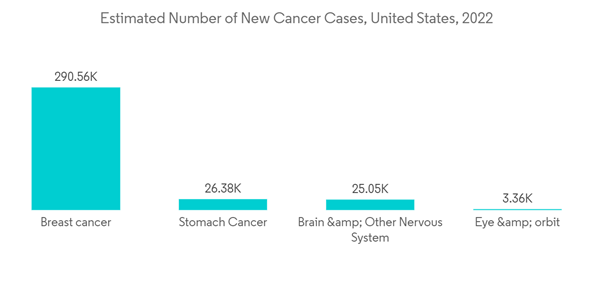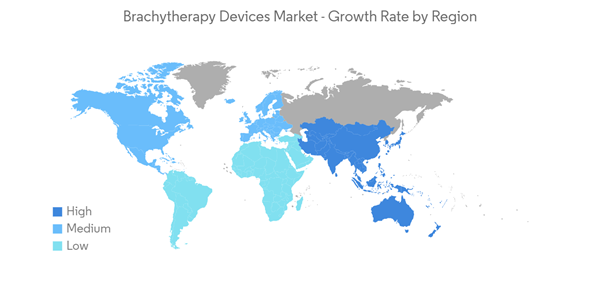The COVID-19 pandemic has affected the healthcare systems globally and significantly impacted the brachytherapy devices market. Per the article published in Cancer Connect 2020, 7 patients with prostate cancer who were scheduled to receive brachytherapy were treated across the four hospitals. However, only 3 patients (43%) were able to undergo brachytherapy. As per the study published in 2021 by Advances in Radiation Oncology, six patients elected to undergo EBRT followed by a brachytherapy boost for unfavorable intermediate- and high-risk diseases. Since elective surgeries were canceled within our system during the pandemic, 4 patients were treated with EBRT with or without androgen deprivation therapy (ADT) only. Despite the challenges, the healthcare system faced during the pandemic, most patients with cancer were safely treated with minor treatment delays and interruptions. Thus, due to the COVID-19 imposed restrictions, the was significantly impacted. However, with the increase in cardiac surgeries, the demand for brachytherapy devices is expected to boost the growth of the market.
Brachytherapy devices are commonly used for effectively treating gynecologic, prostate, breast, and other types of cancer. According to the International Agency for Research on Cancer (IARC), the global incidence of cancer in 2020 was estimated to be around 19.3 million. This is expected to increase to 24.6 million by the year 2030. Furthermore, breast cancer is among the most common types of cancers, with around 2.26 million new cases in 2020. The increasing cancer burden is one of the major factors driving the market. Brachytherapy is related to the implementation of radioactivity within the body to ablate or kill cancer or tumor cells within or near the target area in the body. It is also used in combination with chemotherapy, surgery, or external radiation therapy.
Moreover, In October 2021, Edinburgh Cancer Center announced that it would be offering a high dose rate of brachytherapy for the treatment of aggressive prostate cancer. It is the first cancer care center in Scotland to offer HDR-BT for treating prostate cancer.
According to the IAEA’s Directory of Radiotherapy Centres (DIRAC), as of 2020, around 3300 brachytherapy systems are installed across radiation therapy centers worldwide. Around 60% of the cancer cases occur in Low and Low Middle-Income Countries (LMICs). 80% of patients in these countries lack access to treatment as they have limited access to technologically advanced products. In Low and Low Middle-Income Countries (LMICs), only 3-4% of the radiotherapy needs are met as opposed to 60-80% in the European countries. Other factors, such as rising government initiatives to increase awareness and technological advancements in minimally invasive surgical procedures, are expected to drive the brachytherapy devices market in the forecast period.
However, the lack of skilled radiologists and advanced radiotherapy facilities and reimbursement issues are among the major barrier to the growth of this market over the forecast period.
Key Market Trends
Breast Cancer Segment is Expected to Register a Significant Growth Over the Forecast Period
By application, the market has been segmented into gynecologic cancer, prostate cancer, breast cancer, and others. The breast cancer segment is expected to register significant growth compared to other cancer types. This is majorly attributed to the increasing prevalence of breast cancer worldwide. The American Cancer Society estimated for 2022 that about 287,850 new cases of invasive breast cancer will be diagnosed in women, and about 51,400 new cases of ductal carcinoma in situ (DCIS) will be diagnosed. Breast cancer in the United States in 2022 is expected to grow during the forecast period. Intracavitary brachytherapy is the most common type for women with breast cancer.According to Globocan, in 2020, about 2,261,419 new cancer cases were reported worldwide, contributing to about 11.7% of the total cancer cases. As per Cancer Australia, in 2021, it was estimated that 20,030 new breast cancer cases were diagnosed in Australia (164 males and 19,866 females). The same source reports that in 2021, it is estimated that a person has a 1 in 15 (or 6.7%) risk of being diagnosed with breast cancer by the age of 85 (1 in 8 or 13% for females and 1 in 829 or 0.12% for males). Therefore, the high burden of breast cancer is increasing the demand for breast cancer treatment, thereby contributing to the market segment growth.
In this approach, a device containing a radioactive substance is placed within the body and is left there until treatment is complete. In addition, rising government initiatives to increase awareness and technological advancements in minimally invasive surgical procedures also contribute to the growth of the brachytherapy devices market.
North America Dominates the Market and Expected to do the Same Over the Forecast Period
North America dominates the market owing to the increasing incidences of cancer and early adoption of new technologies. The United States holds the majority of the market in the North American region due to its high patient pool and well-developed infrastructure. According to the Globocan 2020 report, an estimated 2,281,658 new cancer cases were diagnosed in the United States in 2020, with nearly 612,390 deaths. In 2020, The most common cancers were breast (253,465), lung (227,875), prostate (209,512), and colon (101,809) in the United States.Moreover, in the United States, breast cancer is one of the leading cancer types. According to the January 2022 update by Breastcancer.org, about 1 in 8 US women (about 13%) will develop invasive breast cancer over their lifetime. The same source reports that in 2022, an estimated 287,850 new cases of invasive breast cancer are expected to be diagnosed in women in the United States, along with 51,400 new cases of non-invasive (in situ) breast cancer. As per the same source, about 2,710 new cases of invasive breast cancer are expected to be diagnosed in men in 2022. A man’s lifetime risk of breast cancer is about 1 in 833. Furthermore, in an October 2021 update by the University of North Carolina's School of Medicine, Susan G. Komen, the world’s leading breast cancer organization, announced that it would award USD 1.5 million for three new research projects that examine three unique areas focused on metastatic breast cancer (MBC).
Thus, due to the above-mentioned factors, the market is expected to witness significant growth during the forecast period.
Competitive Landscape
The brachytherapy devices market is fairly competitive and consists of several major players. Most of these major players enjoy a global presence and face intense competition in emerging economies. The major players in the brachytherapy devices market include Argon Medical Devices, Becton, Dickinson and Company, Carl Zeiss Meditec AG, Eckert & Ziegler BEBIG S.A., Elekta AB, iCAD Inc., Isoray Inc., Theragenics Corporation, and Varian Medical Systems Inc., which provides these products across the globe.Additional Benefits:
- The market estimate (ME) sheet in Excel format
- 3 months of analyst support
This product will be delivered within 2 business days.
Table of Contents
Companies Mentioned (Partial List)
A selection of companies mentioned in this report includes, but is not limited to:
- Argon Medical Devices, Inc.
- Becton, Dickinson and Company
- Carl Zeiss Meditec AG
- Eckert & Ziegler BEBIG S.A.
- Elekta AB
- iCAD Inc
- Isoray Inc
- Theragenics Corporation
- Varian Medical Systems Inc
- CIVCO Medical Solutions
- Theragenics Corporation
- Argon Medical










